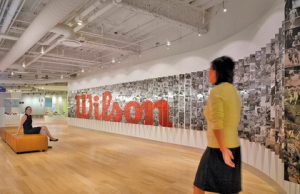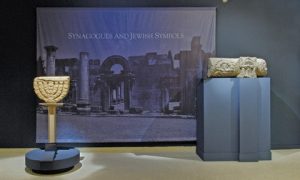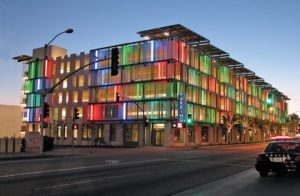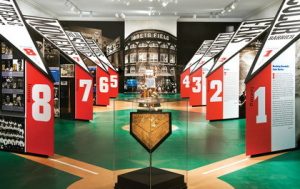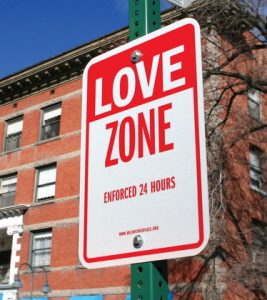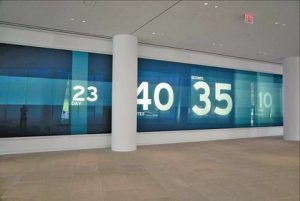Design
The Winners
A gallery of select SEGD Design Award winners
Published
16 years agoon
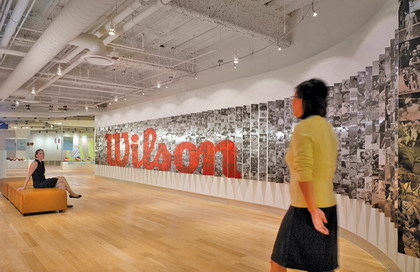
The Society for Environmental Graphic Design (SEGD), a 35-year-old organization that advocates for, and provides educational opportunities to, EGD professionals worldwide, has conducted its Design Awards competition for nearly two decades. The competition celebrates stately, bold or creative programs that reinforce a destination’s image, vitality or message. This sample of winners emphasizes the width and breadth of signage possibilities.
This year’s competition jurists included chairman David Vanden-Eynden, co-principal of Calori & Vanden-Eynden (NYC); Sandro Franchini, graphic-design director for Crate & Barrel (Chicago); Kelly Kolar, principal of Kolar Design (Cincinnati); Tali Krakowsky, director of experience design for Imaginary Forces (Hollywood, CA), a commercial-art firm; Merritt Price, exhibition-design manager for Los Angeles’ J. Paul Getty Museum; Ronald Shakespear, founding principal of Diseno Shakespear (Buenos Aires, Argentina); and Robert C. Whitlock, an architect for Kohn Pedersen Fox (NYC).
Maximum Sports
The Wilson Sporting Goods Co. enjoys an exalted place in the sports world – its gear and apparel see action on professional, collegiate and youth athletic fields worldwide. When the company relocated its Chicago headquarters, the firm enlisted Gensler’s Chicago office to develop the environmental design.
According to Gensler’s Alfred Fiesel and Tony LaPorte, respectively the firm’s project manager and senior brand designer, their EGD followed the mission of Chris Considine, Wilson’s president, to create a brand showcase.
AdvertisementAfter reviewing the facility’s unique, equilateral-triangle shape, the team created a comprehensive program that integrated environmental branding with the architecture. Centerpoint (Woodbury, MN), which has served Wilson’s exhibit-fabrication needs for more than a decade, built a 60-ft.-long graphic wall that featured folded-aluminum with direct-printed, digital graphics. These feature 1,200, 6 x 6-in., black-and-white images of such celebrated, Wilson-clad athletes as Tom Brady and Roger Federer, as well as equipment and historic people and moments in the company’s history. Centerpoint printed these graphics directly on the substrate using a Durst Rho 600 flatbed, UV-ink printer.
The eye-catching product sculptures – a pyramid of sports balls that reference the group effort required to build team success, a golf-ball “quilt” that’s linked together into a gently rolling surface, and a tennis-ball chandelier that references the game’s elegance – comprise actual equipment, which Centerpoint engineered and built through proprietary techniques. LaPorte said, “This project allowed close collaboration between our graphic-design and architectural staffs. This approach helped us to create a holistic, branded environment.”
The Birth of Faith
Although events of the early Christian and Jewish churches have been chronicled in various religious texts, many artifacts from the period have been lost to the opacity of time. Thus, exhibits that feature these remnants require compelling textual graphics that recount their history and evoke the period.
Fort Lauderdale’s (FL) Museum of Art and Atlanta’s Michael C. Carlos Museum at Emory University displayed the 9,800-sq.-ft, “Cradle of Christianity” exhibit, which features 138 artifacts related to Biblical archaeology that date from 1 to 300 A.D. According to McMillan Group (Westport, CT), which designed the exhibit, the program flows through eight galleries, with the oldest articles set up randomly to reflect the early churches’ informality.
AdvertisementKearney & Assoc. (Culpepper, VA) fabricated the exhibit, and Photoworks Creative Group (Charlottesville, VA) specified materials and production techniques. Geoff Kilmer, Photoworks’ president, said the number of approvals required from involved parties in different locations posed the most significant hurdles to graphics production.
To help the exhibits appear antiquated, Photoworks selected Dupont’s Tyvek® coated material because it can be folded or crumpled to appear aged without cracking the ink. To create taut panels, fabricators hemmed the edges and connected the grommets with bungee cords. Photoworks output the Tyvek graphics using its Epson Stylus® Pro9800 with UltraChrome™ K3 VOC-free, pigment-based inks. Photoworks output the photo panels on a LightJet 430 laser-photographic printer, which it protected with thermal laminates applied with a GBC heated-roller laminator.
No Ordinary Garage
Forward-thinking city officials seek ways to cultivate a civic brand that draws excitement and attention – and, of course, generate visitor traffic and enhance the local economy. Santa Monica (CA) city officials enlisted Terry Graboski, co-principal of Beck & Graboski Design Office, a Santa Monica-based EGD firm, to create luminous environmental graphics for a Leadership in Energy and Environmental Design certification (LEED)-compliant parking garage – believed to be the first in the United States, according to Graboski. The firm had worked with the garage’s architect, Moore Ruble Yudell, to create a graphics package for the main branch of the Santa Monica Public Library, and Graboski had also served on the city’s Architectural Review Board.
Although many LEED guidelines pose little or no relevance for EGD, Graboski pursued his contribution. He said, “The LEED-certification system offers one point for incorporating signage that promotes environmental education, and we earned that point by creating signs that explain the garage’s energy-collecting, photovoltaic, rooftop panels.” Also, aluminum and glass, the primary materials, are easily recyclable, which, although small in comparison to quantity of materials required for the overall structure, comply with LEED specs.
AdvertisementC & C Signs (Garden Grove, CA) fabricated the flag-mounted, projecting signage that directs visitors to the entrance with frosted-glass enclosures cantilevered above the structure. For the building’s main-ID sign, C & C fabricated brushed, stainless-steel, reverse-lit channel letters that incorporate white LEDs that proclaim its identity. Pulp Studios (Los Angeles) fabricated the program’s LED-lit, architectural-glass panels, and Woodbridge Glass Inc. (Tustin, CA) produced the U-channel, architectural-glass panels.
The interior wayfinding, pedestrian and parking panels, which CA Signs (Pacoima, CA) fabricated, comprise aluminum panels with cut-vinyl graphics. CA Signs also produced digital graphics for the garage’s walls and columns that complement local artists’ handiwork that’s displayed on each level. Daktronics (Brookings, SD) LED messageboards on the garage’s exterior notify motorists about available spaces.
Fields of Glory
The Museum of the City of New York (MCNY) commissioned this exhibit, titled “Glory Days” New York Baseball: 1947-1957,” to celebrate the apex of Big Apple baseball history – during those years, the Giants, Dodgers and Yankees all called Gotham home. Seminal rivalry moments during these years included 1951’s “Shot Heard ‘Round the World,” when the Giants’ Bobby Thomson homered off the Dodgers’ Ralph Branca to secure the pennant, and the Yankees’ Don Larsen pitched a no-hitter in the 1956 World Series against the Dodgers, among many others.
MCNY contracted Pentagram and Robert H. Guest Inc. (both of NYC) to respectively design and build the exhibit. Robert Guest said time posed the project’s most formidable obstacle. “The windows of time when the gallery was open for construction were very limited, so coordinated installation was a challenge,” he said. “Also, the exhibits presented a tremendous amount of information and imagery to be vetted in a short amount of time.”
Michael Gericke, Pentagram’s partner in charge of the project, said, “The exhibit featured many artifacts that have never been exhibited before. The exhibit tells the story of New York City baseball from that era through Baseball Hall of Fame memorabilia, archival photos, film footage and private collections.”
Pentagram divided the program into 10 sections – one each for a ballgame’s nine innings, plus one extra inning – that feature 10-ft.-tall, pennant-shaped displays. Guest built Pentagram’s specified freestanding or wall-mounted, diamond-shaped, acrylic vitrines that served as backdrops for the digital graphics and exhibit artifacts. Guest applied the graphics directly to the gallery’s wall or glossy, white, Medite® II fiberboard panels.
Guest enlisted Sign*A*Rama of Manhattan to fabricate Glory Days’ digital graphics. According to store owner Glenn Kushner, the shop fabricated all wall installations with 3M’s Controltac IJ180-10 film and Oracal’s Oraguard® 210 matte-finish overlaminate on the shop’s 54-in. Roland DGA Corporation SolJet Pro III-XC540. Kushner produced the exhibit’s cut graphics using Avery Graphics’ A6 intermediate vinyl.
“This job required very exacting standards,” Kushner said. “But, it was well worth it to celebrate such a memorable piece of our city’s history.”
Feel the Love
In Reno, NV, which proudly calls itself the “Biggest Little City in the World,” the signage at its casinos, theatres and other entertainment-related amenities are designed to confer sophistication. However, Glenn Group and Carl’s Imaging Works, an advertising/PR firm and printer, respectively, both of Reno, turned upscale on its ear for We Love This Place!, a guerilla sign campaign. The Glenn Group installed it during the Christmas season in 2005 and preceding Valentine’s Day in 2007.
The firm developed a palette of typefaces and a color scheme that resembled road-safety and traffic-regulations signage, but included such timely and cheerful message’s as “Reindeer Parking Only” and “Do a Good Deed and Don’t Get Found Out.”
According to Wade Hanson, a Carl’s Imaging Works salesperson, the shop produced the graphics with an Océ Arizona solvent-ink printer with 3M or Avery Graphics reflective vinyl and applied them to .060- and .080-in. aluminum panels. However, the project hadn’t been sanctioned by law- and traffic-enforcement officials. Thus, the Glenn Group had to install the signs quickly while on the lookout for cops.
“We decided to post the signs first and ask for forgiveness later,” Paul Hamill, the Glenn Group’s associate creative director, said. “But the response was usually positive. I mean, how can you get in trouble for posting signs about love?”
“We Love this Place” had been used citywide as a feel-good slogan for approximately a decade, but the sign campaign helped reinvigorate civic pride. Many area business adopted it as a promotional slogan, and two local institutions – St. Mary’s Hospital and Bishop Manogue Catholic High School – ordered several signs styled after the campaign and outfitted their campuses.
Brand Interaction
Manhattan, NY’s InterActiveCorp (IAC), a purveyor of more than 60 Internet-based information and service providers (brands include Citysearch and match.com), ordered a state-of-the-art video wall for its Frank Gehry-designed headquarters. Trollbäck + Co. (NYC) developed the 11 x 120-ft. wall, which, according to Joe Wright, Trollback’s executive creative director and partner, subtle diversity, yet firmly, promote IAC’s brands. To that end, the company developed aesthetic modules tailored to the personalities of its myriad brands:
• To extol Match.com and its other dating-related websites, it created the “I Date” system, which features a time-lapse sequence of an opening flower (i.e., the bloom of romance);
• “I Explore,” a live RSS feed from Ask.com that delivers web-based content; and
• For retailing websites, the “I Shop” mode exhibits an eye-catching array of products available through related IAC sites.
Cultivating high-resolution imagery also sometimes proved challenging. For instance, on the “I Date” display, the blossoming flower required shooting time-lapse photography, and other elements required producing computer-generated-image files to create appropriate resolution.
Trollback output final files at 12,912 x 1,200-pixel resolution – reportedly the world’s largest high-resolution video wall – which it rendered in nine separate pieces to meet the requirements of the program’s projection equipment. Dataton’s (Linkoping, Sweden) Watchout software manages the nine computers that transmit information to two projectors apiece, and Vista Systems’ (Phoenix) Spyder data-integration system distributes content to the projectors.
Other project contributors include:
• McCann Systems (Edison, NJ) performed the installation and tested the display;
• Feedtank (Brooklyn, NY) programmed the content;
• Ted Kinsman Photography (Rochester, NY) created the time-lapse photography; and
• Warren Z Productions (NYC) served as a technical partner.

SPONSORED VIDEO
Introducing the Sign Industry Podcast
The Sign Industry Podcast is a platform for every sign person out there — from the old-timers who bent neon and hand-lettered boats to those venturing into new technologies — we want to get their stories out for everyone to hear. Come join us and listen to stories, learn tricks or techniques, and get insights of what’s to come. We are the world’s second oldest profession. The folks who started the world’s oldest profession needed a sign.
You may like

Orbus Celebrates Earth Day With Recycling Achievements

American Sign Museum Names New Executive Director

3 Things Print Pros Must Do to Build Stronger Relationships in the Interiors Market
Subscribe

Bulletins
Get the most important news and business ideas from Signs of the Times magazine's news bulletin.
Most Popular
-

 Tip Sheet1 week ago
Tip Sheet1 week agoAlways Brand Yourself and Wear Fewer Hats — Two of April’s Sign Tips
-

 Photo Gallery2 days ago
Photo Gallery2 days ago30 Snapshots of the 2024 ISA Sign Expo
-

 Ask Signs of the Times4 days ago
Ask Signs of the Times4 days agoWhy Are Signs from Canva so Overloaded and Similar?
-

 Real Deal2 weeks ago
Real Deal2 weeks agoA Woman Sign Company Owner Confronts a Sexist Wholesaler
-

 Benchmarks1 week ago
Benchmarks1 week ago6 Sports Venue Signs Deserving a Standing Ovation
-

 Women in Signs2 weeks ago
Women in Signs2 weeks ago2024 Women in Signs: Megan Bradley
-

 Photo Gallery1 week ago
Photo Gallery1 week ago21 Larry Albright Plasma Globes, Crackle Tubes and More
-

 Women in Signs1 week ago
Women in Signs1 week ago2024 Women in Signs: Ashley Borell
